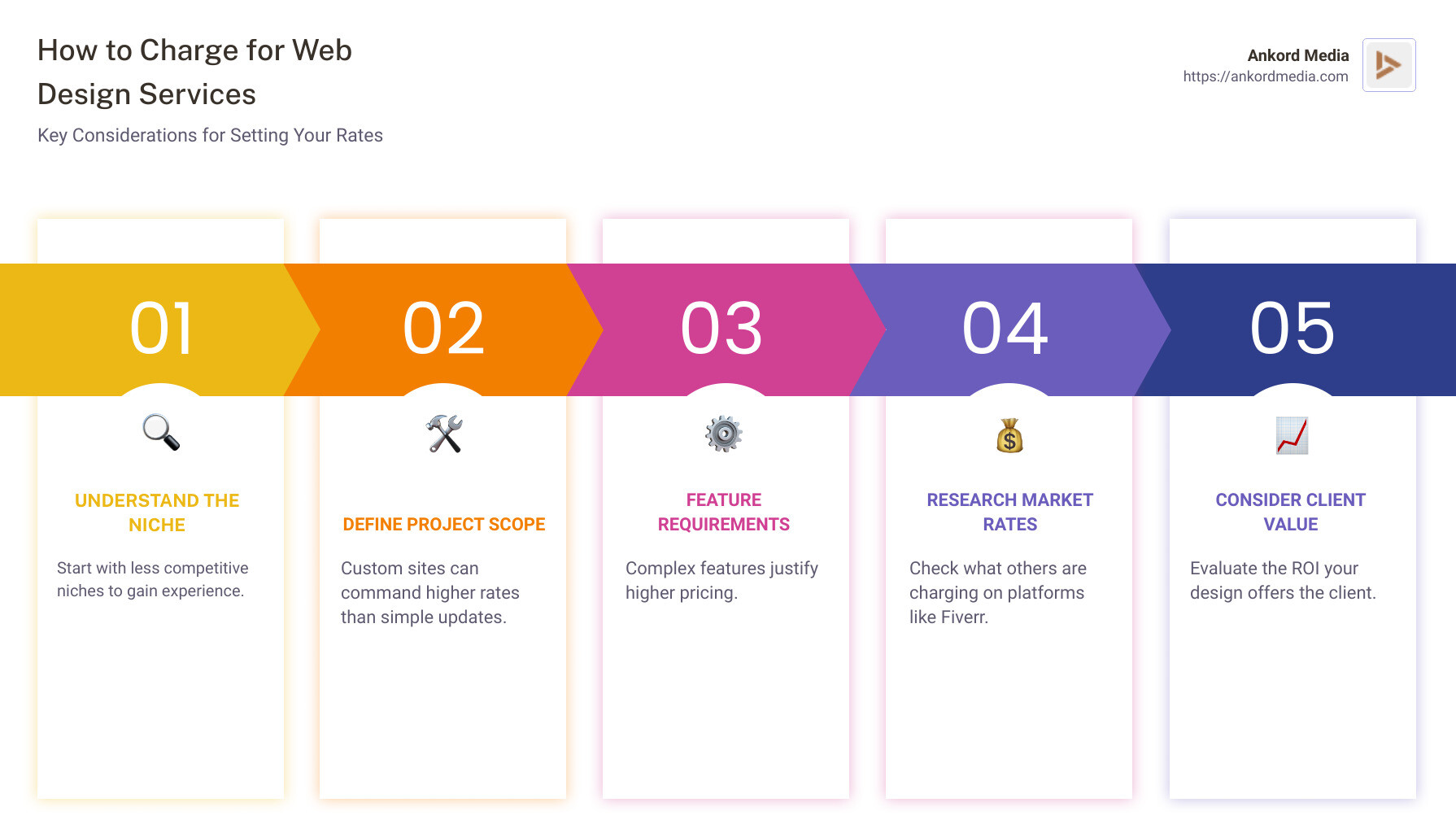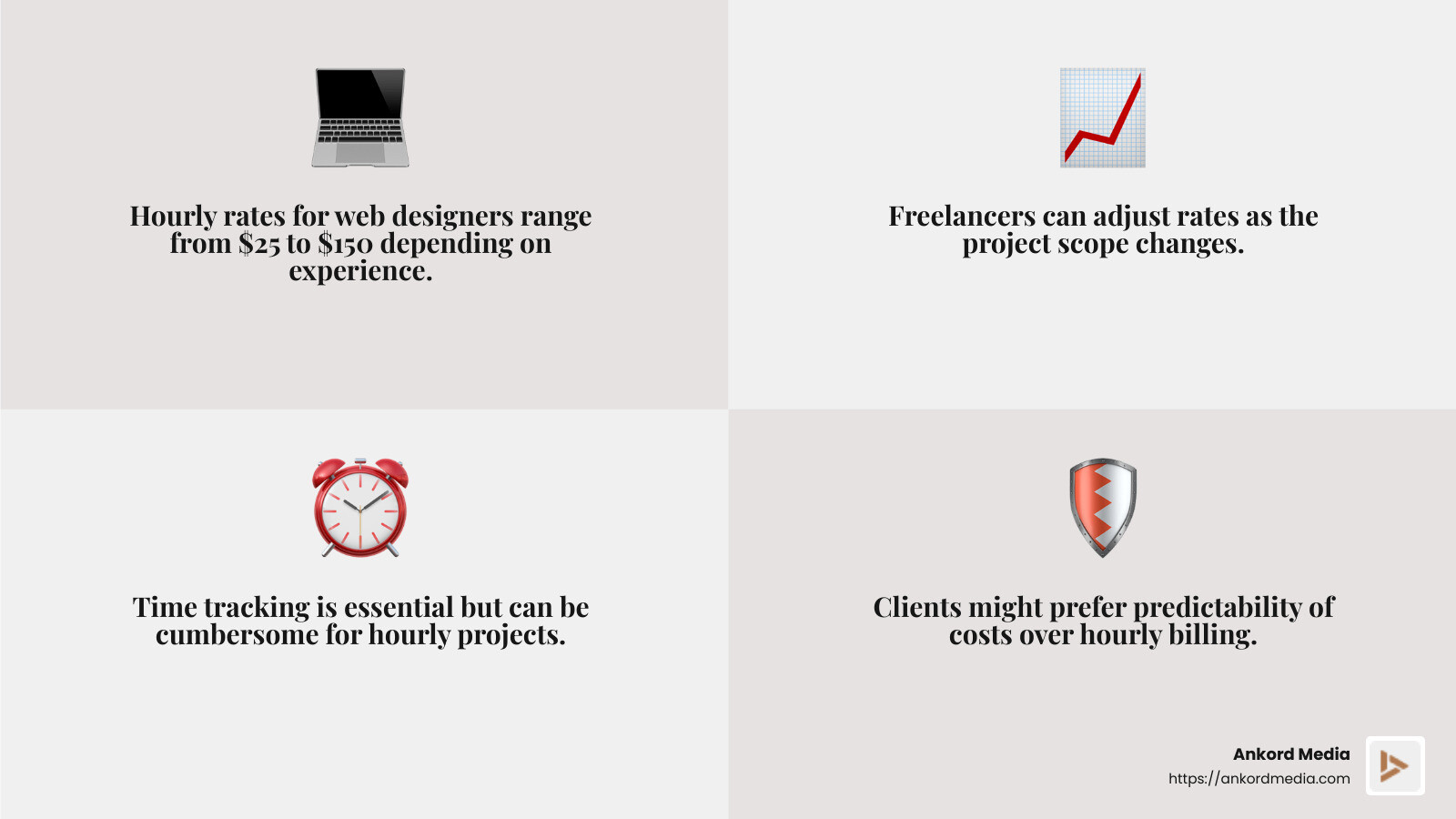
How to charge for web design services is a vital question for anyone entering the web design industry. Setting your rates can be tricky, but here are some key considerations to get you started:
- Understand the Niche: Begin in smaller, less competitive niches to build experience and stand out.
- Project Scope: Custom websites command higher rates than updates to existing sites.
- Feature Requirements: More complex features can justify higher rates.
- Market Rates: Check platforms like Fiverr and Upwork to see what peers are charging.
- Value to Client: Consider the return on investment your design will provide to the client's business.
Web design is more than just making a site look pretty. It's about creating a digital presence that captures a brand's essence and engages its audience. Whether startups or established brands, all businesses understand the importance of a well-crafted website.
I'm Milan Kordestani, CEO and founder of Ankord Media. With my background in creating impactful brands through strategy and innovation, I’ve learned about the challenges of how to charge for web design services in a way that reflects both quality and value.

Understanding Web Design Costs
When setting prices for web design, it's crucial to understand the different components that influence costs. Let's break down hourly rates, flat fees, and project complexity.
Hourly Rates
Charging by the hour is a common method, especially for freelancers. It offers flexibility and transparency. You bill for the exact time you spend on a project. This can be beneficial if a project scope changes or if a client requests additional features.
However, as your skills improve, you might complete tasks faster, which could mean less income for the same work. To counter this, consider adjusting your hourly rate over time. According to research, a skilled freelancer might charge anywhere from $28 to $75 per hour, depending on expertise and project demands.
Flat Fees
Flat fees are another popular option. They allow you and your client to agree on a set price upfront. This can be appealing to clients who want to know their costs before starting a project.
The risk here is underestimating how long a project will take. If you're not careful, you could end up working more hours than planned without additional pay. To avoid this, outline the project scope clearly in a contract and include provisions for any extra work.
Project Complexity
The complexity of a project significantly affects pricing. A simple landing page will cost less than a multi-featured e-commerce site with custom functionalities.
More complex projects require more time and expertise. They may involve designing custom solutions, integrating payment gateways, or creating intricate user interfaces. As a result, they command higher fees.
To set a fair price, assess the complexity and required features at the outset. Consider how much work is needed and the tools or software that might be necessary.
By understanding these factors, you can better steer the pricing landscape in web design. Each project is unique, and finding the right pricing model depends on a mix of these components.
How to Charge for Web Design Services
When deciding how to charge for web design services, several factors come into play. Let's explore market rates, skill level, and project scope to help you set competitive and fair prices.
Market Rates
Understanding market rates is crucial. It gives you a benchmark for what others in the industry are charging. You can research platforms like Upwork or Fiverr to see what similar freelancers charge. For instance, web design projects can range from $500 for basic templates to $5,000 or more for complex sites.
However, don't just copy these rates. Use them as a guide to understand where your services fit in the market. Consider your unique skills and the value you bring to your clients.
Skill Level
Your skill level should heavily influence your pricing. If you're a beginner, you might start on the lower end of the spectrum. However, as you gain experience and specialize in certain niches, your rates should reflect your expertise.
For example, a personal finance website might have clients with tighter budgets. But if you specialize in creating custom e-commerce sites with advanced features, you can charge more because of the complexity and expertise required.
Project Scope
The scope of a project is another key factor. A small project with a few pages will naturally cost less than a large, intricate site with multiple functionalities. It's important to define the project scope clearly from the start.
Create a detailed contract that includes all deliverables and potential revisions. If the client requests additional features or changes, be prepared to adjust your rates accordingly. This ensures you are compensated fairly for any extra work.
By considering these elements—market rates, skill level, and project scope—you can set prices that are competitive yet reflective of your value. This approach not only helps in attracting the right clients but also ensures your business remains sustainable.
Factors Influencing Web Design Pricing
When setting your web design prices, several factors come into play. Understanding these can help you find the right balance between competitive rates and fair compensation. Let's explore the cost of production, client industry, and project size to see how they affect your pricing strategy.
Cost of Production
The cost of production is a fundamental aspect of pricing. It includes all expenses incurred while creating a website. This can range from software subscriptions and hosting fees to the cost of premium plugins and themes.
For instance, if you use specialized tools or hire additional help for certain aspects of a project, these costs should be factored into your pricing. Failing to account for all production costs can lead to undercharging and reduced profitability.
Client Industry
The industry your client operates in can significantly influence your web design pricing. Some industries have clients with larger budgets, while others might be more cost-conscious.
For example, a startup in the tech industry might be willing to invest more in a cutting-edge website than a small local business. On the other hand, industries like personal finance might prioritize budget-friendly options, as they focus on cost-saving strategies.
Understanding your client's industry can help you tailor your offerings and price them appropriately.
Project Size
The size and complexity of a project are major determinants of its cost. A simple website with a few static pages will naturally cost less than a comprehensive e-commerce platform with advanced features like payment gateways and user accounts.
It's crucial to clearly define the project size and scope from the beginning. This helps in setting accurate pricing and avoids surprises for both you and your client.
Additionally, be prepared for scope changes during the project. If a client requests additional features or modifications that increase the project's size, your pricing should reflect these changes to ensure fair compensation.
By considering these factors—cost of production, client industry, and project size—you can set web design prices that are both fair to clients and sustainable for your business. This approach not only helps you attract the right clientele but also ensures you cover all your bases financially.
Pricing Models for Web Design
When thinking about how to charge for web design services, choosing the right pricing model is key. The model you choose can influence your income, client satisfaction, and the type of projects you attract. Let's explore three common pricing models: hourly rate, flat fee, and monthly rate.
Hourly Rate
Charging by the hour is straightforward. You bill clients for each hour you work on their project. This method is common, especially for smaller projects or when the project scope is uncertain.
Pros:- Flexibility: If the project scope changes, you can easily adjust the hours billed.- Pay for Effort: You get compensated for every hour spent, including meetings and revisions.
Cons:- Unpredictability: Clients might be wary of unpredictable costs if the project takes longer than expected.- Time Tracking: Requires diligent tracking of hours, which can be cumbersome.

Flat Fee
With a flat fee, you set a fixed price for the entire project. This model is appealing for clients who prefer knowing the total cost upfront.
Pros:- Clarity: Clients know exactly what they'll pay, which can build trust.- Efficiency: Encourages efficient work, as you're not paid more for taking longer.
Cons:- Risk of Underestimation: If you underestimate the time or resources needed, you might end up earning less per hour than anticipated.- Scope Creep: Without clear boundaries, clients might request additional work without extra pay.
Monthly Rate
A monthly rate works well for ongoing work, like website maintenance or updates. You charge a recurring fee, providing stable income.
Pros:- Steady Income: Provides a predictable revenue stream, which is great for financial planning.- Client Retention: Encourages long-term relationships with clients.
Cons:- Commitment: Requires ongoing availability, which might limit your ability to take on new projects.- Scope Clarity: Must clearly define what's included in the monthly rate to avoid misunderstandings.
Each pricing model has its strengths and weaknesses. The best choice depends on your business goals, the nature of the projects you undertake, and your clients' preferences. By carefully considering these factors, you can select a model that supports both your financial goals and your clients' needs.
Frequently Asked Questions about Web Design Pricing
How much should I charge for designing a website?
Determining how much to charge for designing a website can be tricky. It largely depends on factors like the project's complexity and your skill level. For instance, building a simple landing page might cost less, while a full-fledged e-commerce site could command a higher price due to its complexity and the features required.
Hourly rates are a common approach, especially for freelancers. As per the research, these can range from $28 to $75 per hour, depending on experience and project demands. However, some designers prefer flat fees, which can range from $500 to $6,000 or more. This approach provides clarity for clients and can be beneficial if you have a good grasp of the project scope.
How do you price a web service?
Pricing a web service involves considering the type of website you're designing and any software costs involved. For example, if you're working on a business site that requires specific functionalities like integrated payment systems, this will affect your pricing.
Start by assessing the software tools and technologies needed. These might include content management systems (CMS) or e-commerce platforms, which often come with their own costs. You should factor these into your pricing. Additionally, consider the value your service brings to the client's business—designing a site that boosts sales or improves brand visibility can justify a higher price.
How much can you charge to manage a website?
Website management is an ongoing service that can be charged on a monthly basis. It includes tasks like maintenance, updates, and performance monitoring. For simple sites, a monthly fee might range from $50 to $200. However, managing an e-commerce site could demand more, given the need for regular updates, security checks, and possibly inventory management.
E-commerce sites often require more attention due to their complexity. You may need to handle tasks like setting up payment gateways or managing product listings, which can justify higher fees. The key is to ensure you clearly outline what your management service includes, so clients understand the value they're receiving.
Conclusion
In the changing world of web design, setting your pricing strategy can make or break your business. At Ankord Media, we understand the importance of strategic branding and impactful storytelling in crafting digital experiences that resonate with your audience.
Our approach to web design pricing is rooted in aligning our services with the unique needs of our clients. We believe in partnering with visionary clients to transform bold ideas into tangible success. This means our pricing is not just about covering costs—it's about delivering value that propels your brand forward.
Strategic branding is at the heart of what we do. We don't just design websites; we build platforms that tell your story and connect with your customers. This requires a deep understanding of your brand's values and goals, which we translate into every pixel and line of code.
Impactful storytelling is the key to engaging your audience. We leverage a unique blend of design aesthetics and behavioral science to create websites that not only look good but also drive results. Our storytelling approach ensures that your brand message is clear and compelling, helping you stand out in a crowded digital landscape.
By focusing on these core elements, Ankord Media ensures that our web design services are not just a one-time expense but an investment in your brand's future. Whether you're a small business or a global enterprise, our goal is to amplify your visionary ideas and turn them into reality.
If you're ready to lift your brand through strategic web design, explore our services and see how we can help you achieve your goals.


